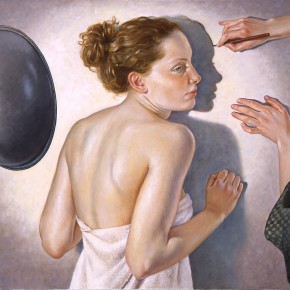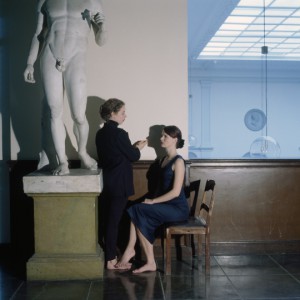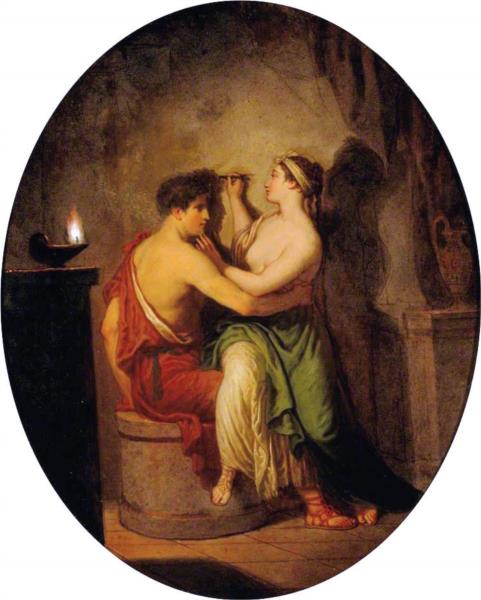Hosting Shadows

“She does not represent her lover; she presents her lover at the threshold of appearing and fading away. Painting lets her see—and show—this sacred threshold that opens all presence.”
“Art is not a matter of some shadow world that could be opposed, in any simple sense, to the real world of the living. Art upsets the opposition between these two worlds, causes each to slip into the other.”
- Sarah Kofman, “The Melancholy of Art”

Karen, Knorr, “The Pencil of Nature,” 1994, photograph
One of my earliest experiences with art was an encounter with shadows. It was an “open house” evening (year 2 of primary school, I believe) during which parents visited the classroom of their children and learned about the various activities and lessons that were happening at school. That year, my teacher had organized an art project which we presented to our parents. The week prior to the open house evening, the students in my class had taken turns sitting next to an overhead projector as its light cast our shadows onto a sheet of paper hanging on the wall. Our teacher would trace the shadow of each student onto the paper, forming a profile silhouette from the neck up. Our job was to carefully cut out our own silhouettes. On the open evening, the silhouettes were lined up on a wall of the classroom, without names. It was the job of the parents to find the silhouette of their child. “There you are.”
The experience must have touched me profoundly because this is one of my most vivid memories from childhood. It is an experience of being seen and recognized, known, while at the same time remaining hidden. The unique line of my forehead curving down into the shape of my nose and down again into the curves of my lips and my chin was enough to let my parents see me out of a crowd of anonymous silhouettes. And yet the trace of my shadow did not only reveal or uncover. It also held back, holding within itself the mystery of (my) existence. It is within this tension between showing and hiding, presence and absence, coming and going, that the silhouettes on the wall offered their “truth.” Human life and relation is that tension, and the art that evening gave access to it.
What does art, visual art in particular, do for us? Imagine if prior to that open evening neither my parents nor I had ever encountered a work of visual art. Imagine if our home had no art on any of its walls—no paintings, no photographs, no scribbles on paper attached to the fridge. What would be different after that open evening? What would have opened that, prior to encountering visual art, lay dormant?

Francine Van Hove, “Dibutades,” 2007, oil on canvas.
There are numerous myths about the origin of painting that circulate within various cultures. One of the most suggestive comes from the first century Roman author Pliny, who tells a story of the invention of painting by a Corinthian woman. On the eve of her lover going off to war, she traces his shadow on the wall of her house. The first image is born. In that moment, painting comes into existence.
How to interpret this story? What is it telling us about the truth of visual art? One way to interpret it would be along Platonic lines. In Plato’s famous “allegory of the cave,” human beings are forced to watch a play of shadows on the wall of the cave in which they dwell. They mistake these shadows for reality itself and so remain unenlightened, slaves to their own ignorance. What they need is a teacher who can liberate them from their attachment to shadows by leading them out of the cave into the real world.
If we interpret Pliny’s story within this framework, painting comes into existence as the birth of representation. The Corinthian woman creates a “stand in” for the reality of her lover, who is going away. As such, her artwork is at best a derivation. Painting, or the visual image in general, is a deficient or “less real” phenomenon than the thing itself, reality itself, just as a person’s shadow is merely a derivate appearance of a person’s form. Attachment to painting, or to images, would then be akin to an unenlightened attachment to shadows, to mere appearances. The male lover, the enlightened human being, leaves the cave and goes off to war, while the woman stays at home in the cave and gazes at images, at shadows.+

David Allan, “The Origin of Painting,” 1775, oil on panel, 38 x 31 cm.
What if we play with Pliny’s story differently and free it from a Platonic interpretation? What if we let it become instead a myth about the tensions and depth of visuality and the role of art in giving us access to and keeping us in touch with the profundity of seeing and looking as the finite beings that we are? What if we let the cave with its shadows be the sight of truth itself rather than its occlusion?
A different interpretation of Pliny’s story might proceed by centering not the distinction between reality and its representation but rather what drives the tension of the scene, namely, the woman’s desire. Gazing upon her lover on the threshold of his departure, the origin of painting happens when she sees something she has not seen before, or she sees a truth in what she had previously only registered as a mundane occurrence. Noticing her lover’s shadow upon the wall, the woman suddenly feels a poignant truth, that her lover in a sense is already gone, that he has always already left, that his presence is at the same time a kind of absence, an arrival that is also a departure. She sees the fragility and fleetingness of his existence, not as derivative of reality but as constitutive of it. Tracing her lover’s shadow is what lets her touch his finitude, the wondrous passing of his existence. She does not represent her lover; she presents her lover at the threshold of appearing and fading away. Painting lets her see—and show—this sacred threshold that opens all presence. “Art does not reproduce the visible; rather, it makes visible.”[1]
At the origin of painting is not representation (presenting a “copy” of reality) but desire reaching out to trace and show the finitude of existence—and in doing so consenting to it. Rather than demand that her lover stay, or that she go with him, the Corinthian woman engages the space of her lover’s difference from himself, his passing, the open time and space of existing. She sees it, or sees that she sees it, and the line of her tracing draws out a non-acquisitive desire. Painting comes into existence as an “open house” that hosts the finitude of things, the arrival of their departure. Painting lets beings be.

Joseph-Benoit Suvee, “Invention of the Art of Drawing,” 1791, oil on canvas, 267 x 131 cm
Returning to my year 2 “open house,” let us imagine that my parents took home my silhouette and put it up on a wall in our house as the very first piece of art ever to grace our home. A simple gesture, but a transformational one. What could they see of me that they had not before? Perhaps only that they see me, or simply that they see. But with this “that” comes the full force of intimacy and its passion. To see those we love, to see that we see them, is to face the absence of any foundation on which their presence is based. The absence of any substance or guarantee that would “fix” them beneath their dis/appearance. To see is to receive the truth of presence as an absolute surprise, a fragile arrival that cannot be owned, a passing whose shadows trace an opening that gives both joy and sorrow.
All it takes is a single line.
Written by Peter Kline, academic dean and lecturer in systematic theology at St Francis College, part of the Charles Sturt University School of Theology. Peter is also an artist.
[1] Paul Klee, “Creative Confession,” in Creative Confession and Other Writings (London: Tate, 2014).
